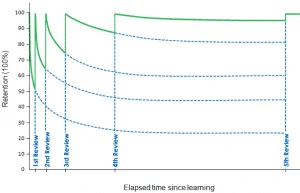With Spring around the corner, lots of students are starting to feel as though they are drowning in tests, assignments and everyday homework. However, this is not the time to de-prioritize your notes. Rather, it’s time to make sure they are living up to your standards.
Understanding the importance of taking good notes
To make good notes, it is essential to understand how and why notes can be useful. Having good notes can be useful for several reasons:
- Be a great tool to help you review content
- Help you understand tricky concepts
When you are trying to remember information, notes are extremely important as they provide you with something to review. Let’s take a look at a memory graph. When you initially learn a new concept in class, your immediate retention (i.e. what you absorb/remember from class) will be 100%. However, if you don’t review the information, your retention will decrease over time. Finally, landing somewhere around 20%. But if you review the information just ONCE, your retention again increases to 100% as you look at the material to remind you what happened during the class, and with time, lands around 50%.

Thus, by the 4th time you review something, you’ve basically learnt it. Now, we’ve established the importance of making good revision material, how do you actually make it? While there are a great variety of ways to make revision material, this blog post will focus solemnly on notes.
Essentials to good notes:
Using your own words!
While it extremely tempting to simply copy what your teacher is saying, this is not an effective way to learn. A thumb rule I tend to use: If I don’t understand a word, I don’t write it down. If I don’t understand it initially, there is no chance I’ll remember what it meant in 3 weeks time. While this might make your sentence more scattered and not as eloquent as when your teacher says them, it will ensure that your understanding is much better.
Keep them brief!
Honestly, as an IB student, time is incredibly limited to begin with. You don’t want the additional task of having to read through notes that are pointless. Therefore, make sure to keep your notes brief and concise. This is easily done by asking yourself:
- Am I going to need this information in an exam/internal assessment situation? If YES, write it down.
- Is this unnecessary information or the essentials? I.e. While knowing the date, importance and commander of a specific battle during WWI may be essential, you don’t need to know the Commander’s family tree…
Further, to ease the process of taking notes, consider using symbols for words that come up often. I used to use the arrow ( →) to indicate that something happened on that date. For example, Germany invade Poland → 1st September 1939. Meanwhile, △ meant therefore. I.e. Study takes place in a laboratory setting, → △, the study lacks ecological validity. While these are small changes, they can change the amount of time you are spending on your notes and make your notes more digestible.
Don’t be afraid to make them ugly!
With all these fancy Instagram study accounts, you might be tricky yourself that to make good notes, they have to be pretty. However, as the cheesy proverb goes – The beauty is in the eye of the beholder. Your notes will only feel beautiful and useful to you if you can understand them. Thus, don’t be afraid to cross out things, use a million arrows, only one color etc. You aren’t trying to gain a Diploma in Note Taking, you are trying to secure an IB Diploma. Make your notes with the purpose of trying to remember information, rather than with the purpose of being able to hang them in a museum.
Have a specific place where you record notes!
This is an easy one; split your notes according to distinct categories. In other words, have separate notebooks/word files for your different subjects. Don’t use one notebook for all your IB subjects – It’ll be a mess! Use different notebooks and distinguish between different topics. An easy way to distinguish in what relevant/new topics start and stop is simply by using a new page.
Structure of good notes:
 The Note Taking technique which I personally prefer is the Cornell note-taking method. Cornell’s method involves dividing your A4 into into 3 parts:
The Note Taking technique which I personally prefer is the Cornell note-taking method. Cornell’s method involves dividing your A4 into into 3 parts:
- Use the Note Taking Area to take notes in your class
- Use the Cue Column to review your notes. After class, go back and read the Note Taking Area. Write down the key topics, people, events and questions which will help you remember what is in the Note Taking Area
- In the Summary section, write 1-2 sentences which summarise exactly what is in your Note Taking Area.
More note-taking help here!



